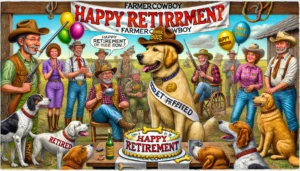
Pussycat Ranch A photorealistic wide aspect image of a female rancher in Texas standing in a vast field. She is wearing a cowboy hat a plaid shirt jeans and boots2.webp.jpeg
Thriving as a Female Cattle Rancher: Insights and Strategies
Introduction
Female cattle ranchers are breaking new ground in a field that has traditionally been dominated by men. With dedication, innovation, and a passion for sustainable practices, women are proving that they can not only succeed but also excel in the cattle ranching industry. This article provides essential strategies and insights to help female ranchers thrive, from accessing financial resources to implementing cutting-edge technologies.
1. Overcoming Challenges in a Male-Dominated Industry
Building Confidence and Resilience
Confidence and resilience are crucial for female ranchers navigating a male-dominated industry. Developing these traits involves seeking out mentorship, participating in leadership training, and engaging in self-advocacy. Building a network of supportive peers and mentors can provide valuable encouragement and guidance.
Leveraging Women’s Agricultural Organizations
Organizations such as the American Agri-Women and Women in Ranching Network offer resources, networking opportunities, and advocacy specifically for women in agriculture. Joining these groups can help female ranchers connect with like-minded individuals, access educational resources, and gain a stronger voice in the industry.
2. Financial Strategies for Female Ranchers
Accessing Loans and Grants
Securing funding can be challenging for female ranchers, but several programs and grants are available to support women in agriculture. Key resources include:
- USDA Farm Service Agency (FSA) loans
- Sustainable Agriculture Research and Education (SARE) grants
- Private foundations offering women-specific agricultural grants
Financial Planning and Budgeting
Effective financial planning and budgeting are essential for the sustainability of a ranch. Female ranchers should develop detailed financial plans that include projections for income and expenses, strategies for managing debt, and plans for reinvestment. Working with an agricultural financial advisor can provide valuable insights and assistance.
3. Implementing Sustainable Ranching Practices
Soil Health and Regenerative Agriculture
Maintaining healthy soil is critical for sustainable ranching. Practices such as cover cropping, rotational grazing, and reduced tillage can improve soil health and productivity. Female ranchers can lead the way in adopting regenerative agriculture practices that enhance the long-term viability of their land.
Water Conservation Techniques
Water conservation is another key aspect of sustainable ranching. Techniques such as rainwater harvesting, efficient irrigation systems, and planting drought-resistant forage can help ensure a reliable water supply for livestock. Implementing these practices can reduce costs and improve the ranch’s environmental footprint.
4. Embracing Technological Advancements
Utilizing Modern Tools
Modern tools and equipment can significantly enhance the efficiency of cattle ranching operations. Technologies such as GPS for tracking cattle, drones for monitoring land and herds, and automated feeding systems can streamline daily tasks and improve overall management.
Data Management and Analytics
Effective data management is essential for making informed decisions. Software solutions like CattleMax and AgriWebb offer comprehensive tools for managing livestock records, financial data, and operational activities. Utilizing these technologies can help female ranchers optimize their operations and improve profitability.
5. Marketing and Branding Strategies
Developing a Strong Brand
A strong brand can differentiate a ranch in a competitive market. Female ranchers should focus on creating a brand that reflects their unique values, sustainable practices, and high-quality products. Effective branding involves consistent messaging across websites, social media, and marketing materials.
Direct-to-Consumer Marketing
Selling directly to consumers can increase profit margins and build stronger customer relationships. Farmers’ markets, on-site farm stores, and online sales platforms are excellent avenues for direct sales. Hosting farm tours and events can also attract and engage customers, providing an opportunity to showcase the ranch’s operations and products.
6. Networking and Community Engagement
Joining Professional Associations
Being part of professional associations provides valuable networking opportunities and access to resources. Organizations such as the National Cattlewomen’s Association and local agricultural cooperatives offer platforms for learning, advocacy, and collaboration. Networking with other ranchers can lead to new ideas and partnerships.
Community Involvement
Building strong relationships with local communities can enhance the ranch’s reputation and support network. Engaging with local schools, participating in community events, and collaborating with other local businesses can foster goodwill and mutual support. Female ranchers can also benefit from local mentorship programs and peer support groups.
7. Animal Welfare and Ethical Practices
Best Practices for Livestock Care
Ensuring the well-being of livestock is crucial for successful ranching. Female ranchers should implement best practices for animal welfare, including:
- Regular health check-ups and vaccinations
- Providing adequate nutrition and clean water
- Ensuring safe and comfortable living conditions
- Using low-stress handling techniques
Obtaining Ethical Certifications
Consumers are increasingly concerned about the ethical treatment of animals. Obtaining certifications such as Certified Humane or Animal Welfare Approved can enhance the ranch’s reputation and appeal to conscientious consumers. Transparent communication about animal welfare practices builds trust with customers.
8. Education and Continuous Learning
Formal Education Opportunities
Pursuing formal education in agriculture or business management can provide valuable knowledge and skills. Many universities and colleges offer degrees in agricultural sciences, animal husbandry, and business administration. Scholarships and grants specifically for women in agriculture can make these programs more accessible.
Continuing Education and Professional Development
Staying updated with industry advancements through workshops, webinars, and conferences is essential. Organizations like the National Sustainable Agriculture Coalition and American Society of Agronomy offer various educational resources. Participating in these events can help female ranchers stay informed about the latest practices and technologies.
9. Work-Life Balance and Personal Well-being
Managing Multiple Roles
Balancing the demands of ranching with personal and family responsibilities can be challenging. Female ranchers should prioritize effective time management and delegate tasks when possible. Creating a supportive network of family, friends, and fellow ranchers can also help manage multiple roles more efficiently.
Prioritizing Health and Wellness
The physical and mental well-being of ranchers is crucial for long-term success. Regular exercise, a healthy diet, and activities such as yoga or meditation can promote overall well-being. Taking time for hobbies and relaxation is important for maintaining a healthy work-life balance.
Conclusion
Female cattle ranch owners and operators are making significant strides in an industry traditionally dominated by men. By leveraging available resources, embracing innovative practices, and fostering supportive networks, women in ranching can overcome challenges and achieve remarkable success. This comprehensive guide aims to provide practical advice, inspiration, and support to empower female ranchers, ensuring a vibrant and sustainable future for the industry.
How This Guide Helps Farmers
This guide offers female cattle ranch owners and operators valuable insights and actionable advice on navigating the industry, accessing funding, implementing sustainable practices, leveraging technology, building strong brands, networking, enhancing animal welfare, pursuing education, and achieving work-life balance. By addressing these key areas, it aims to support and empower women in the cattle ranching industry, promoting growth and success.

Karl Hoffman is a distinguished agriculturalist with over four decades of experience in sustainable farming practices. He holds a Ph.D. in Agronomy from Cornell University and has made significant contributions as a professor at Iowa State University. Hoffman’s groundbreaking research on integrated pest management and soil health has revolutionized modern agriculture. As a respected farm journalist, his column “Field Notes with Karl Hoffman” and his blog “The Modern Farmer” provide insightful, practical advice to a global audience. Hoffman’s work with the USDA and the United Nations FAO has enhanced food security worldwide. His awards include the USDA’s Distinguished Service Award and the World Food Prize, reflecting his profound impact on agriculture and sustainability.






The internet has changed the game for education, offering an endless supply of resources. ??